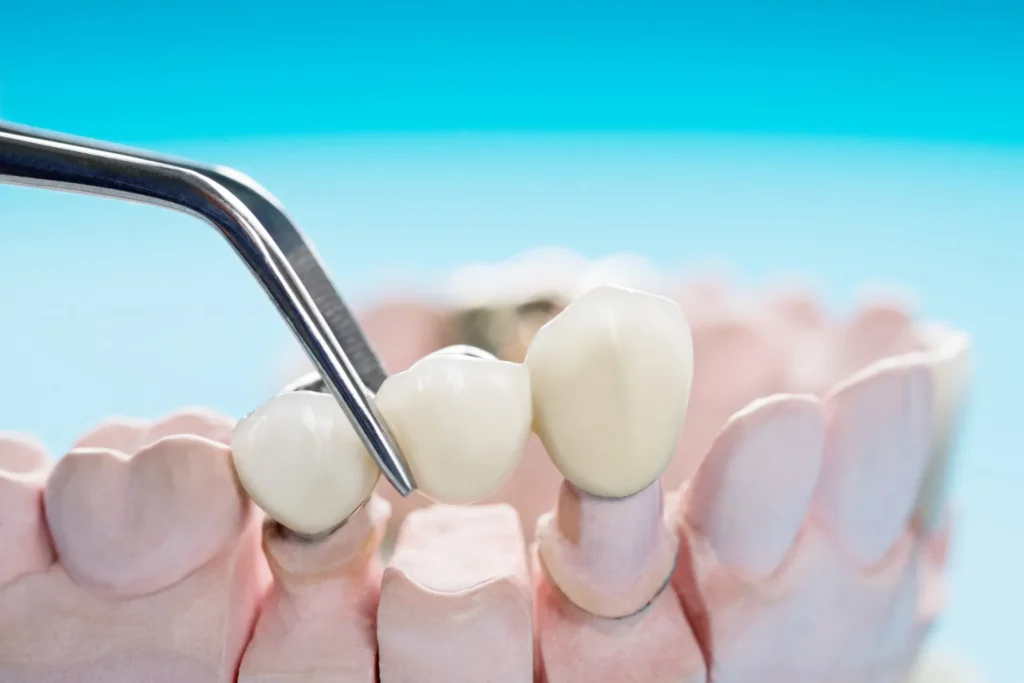Crowns and Bridges
Dental Crowns
A dental crown is constructed to restore a tooth to its original size and shape following extensive dental treatment like a root canal or extraction, advanced tooth decay removal or a broken tooth. Crowns can be made out of several types of materials. Porcelain dental crowns, in particular, are very durable and are popular among dental patients because they can be made to resemble the natural tooth.
Crowns are used for the following reasons:
Crown placement:
- The first appointment includes taking diagnostic models of your tooth to prepare for the construction of the final crown. At the same appointment your dentist will numb the tooth and prepare the tooth by removing decay and creating the ideal surface for your future crown. While the laboratory constructs your future crown you will be fitted with a temporary crown.
- At the Second appointment, which is generally scheduled two weeks after the first appointment, the temporary crown is removed and the custom crown is tried in to verify fit. At this point your dentist will make any necessary adjustments and permanently cement the crown in place.

Need To Schedule OR Have A Question?
Dental Bridges
A bridge is similar to a crown in that it restores missing tooth structure. The major difference is that a bridge restores one or more missing or damaged teeth between existing teeth. There are several types of dental bridges and the dentist is prepared to discuss the best option to fit your individual needs.
- The most popular type of bridge is the traditional bridge, which is constructed from a metal base that has porcelain layered on top of it to give it a natural tooth look.
- This type of bridge consists of two crowns that are supported by teeth and are on both sides of a missing tooth. An artificial tooth is attached to the anchor teeth creating a bridge. Filling the gap can be done by one or more teeth.

Reasons your dentist may recommend fixed bridges include:
- To maintain shape and function of the dental arch.
- To prevent drifting of the remaining teeth.
- To restore your chewing and speaking ability.
- To fill the space of missing teeth and even an upgrade from a removable partial denture to a fixed appliance.
Once your final bridgework is complete from the laboratory you will return to our office for your second visit. At this visit your dentist will try-in this final bridge. If no adjustments are necessary then it will be permanently cemented in place.
FAQs
1. Why might I need a dental crown?
Crowns restore teeth that are broken, cracked, severely decayed, or weakened after a root canal. They provide strength, protect the tooth, and improve appearance. Dr. Harter recommends crowns when a filling would not provide enough support for long term success.
2. What is the process for getting a crown?
The first visit includes preparing the tooth, removing decay, and placing a temporary crown. The dental lab creates your custom crown, and at the second visit, Dr. Harter checks the fit and permanently cements it. The entire process usually takes about two weeks.
3. How does a dental bridge work?
A bridge replaces one or more missing teeth using crowns on the surrounding teeth as anchors. An artificial tooth connects the crowns to fill the gap. This restores chewing, prevents shifting, and maintains the shape of your dental arch.
4. How long do crowns and bridges last?
With proper oral hygiene and routine dental visits, crowns and bridges can last 10 to 15 years or longer. Avoid chewing hard objects, maintain good brushing and flossing habits, and follow Dr. Harter’s recommendations to extend their lifespan.
5. Does getting a crown or bridge hurt?
Most procedures are comfortable due to local anesthetic. You may experience mild sensitivity after the appointment, but this typically improves quickly. If needed, Dr. Harter provides additional guidance to keep you comfortable throughout your treatment.
